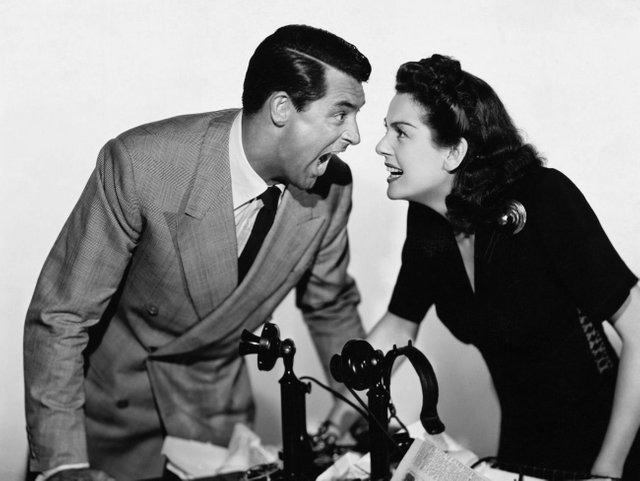LAUGHTER IS THE BEST MEDICINE
In the 1930s, the USA was in the middle of the Great Depression: an enormous, worldwide economic crisis. The Depression began with the Wall Street Crash in October 1929, when previously wealthy investors lost millions of dollars. The effects of the crash soon spread around the world, but the USA was one of the most seriously-affected countries. Factories, offices and banks closed, and by 1935, 25% of people had no job. Thousands of people lost their homes, and destitute agricultural workers began to migrate to cities.
Astonishingly, in spite of these difficulties, Americans didn’t go to the movies less regularly between 60 and 80 million of them still went every week. Many people were very poor, but they paid to see the latest films. Perhaps less surprisingly, the most successful films at the time were optimistic musicals and comedies.
Laurel and Hardy had become popular in silent films during the 1920, due to their slapstick humour. Slapstick was very visual: the characters often had accidents or fights, but with no serious consequences. People continued to enjoy Laurel and Hardy during the ten years of the Depression. Their characters seemed to represent the common people: they had problems, but they were funny and likeable. The Marx brothers were equally popular. Their films laughed at figures of authority, and at traditional institutions and values.
Films with sound, or ’talkies’, could now use language to make people laugh, so during the Depression comedy became more sophisticated. Hollywood responded to the Depression with films that were fast-paced, sharp and funny, and which always sympathised with the lower, working classes. Americans loved this type of screwball comedy, and it made huge stars of actors such as Clark Gable and Cary Grant.
The Great Depression had a devastating effect on both rich and poor around the world. The cinema boom of the 1930s suggests that films offered a good form of escapism. It seems that people used laughter to help them see life more brightly at this hard time. Had they, perhaps. discovered that laughter really is the best medicine?
ITALIAN VERSION
Negli anni 1930, gli USA erano al centro della Grande Depressione: un'enorme crisi economica mondiale. La depressione è iniziata con il crash del Wall Street nel mese di ottobre 1929, quando gli investitori precedentemente ricchi hanno perso milioni di dollari. Gli effetti del crash presto si sono diffusi in tutto il mondo, ma gli Stati Uniti sono stati uno dei paesi più colpiti. Le fabbriche, gli uffici e le banche si sono chiuse e, nel 1935, il 25% delle persone non ha avuto lavoro. Migliaia di persone hanno perso le loro case, e i lavoratori agricoli poveri hanno cominciato a migrare nelle città.
Sorprendentemente, a dispetto di queste difficoltà, gli americani non andavano meno frequentemente nei film da 60 a 80 milioni di persone che andavano ancora ogni settimana. Molte persone erano molto povere, ma pagavano per vedere i film più recenti. Forse meno sorprendentemente, i film di maggior successo al momento erano musicali e commedie ottimistiche.
Laurel e Hardy erano diventati popolari in pellicole silenziose durante il 1920, a causa del loro umore comico. Il comico era molto visto: i personaggi spesso avevano incidenti o lotte, ma senza gravi conseguenze. La gente continuava a godere di Laurel e Hardy durante i dieci anni della depressione. I loro personaggi sembravano rappresentare la gente comune: avevano problemi, ma erano divertenti e simpatici. I fratelli Marx erano altrettanto popolari.
I film con suono, o "chiacchiere", ora può usare il linguaggio per far ridere le persone, per cui durante la depressione la commedia è diventata più sofisticata. Hollywood ha risposto alla Depressione con film che sono stati veloci, taglienti e divertenti e che hanno sempre simpatizzato con le classi lavoratrici più basse. Gli americani amavano questo tipo di commedia da caccia, e gli attori come Clark Gable e Cary Grant diventarono delle star.
La Grande Depressione ha avuto un effetto devastante sia sui ricchi che sui poveri in tutto il mondo. Il boom del cinema del 1930 suggerisce che i film offrivano una buona forma di scappamento. Sembra che la gente abbia usato risate per aiutarli a vedere la vita in modo più luminoso in questo momento difficile. Hanno forse scoperto che la risata è davvero la migliore medicina?

Welcome to Steem @sciack I have upvoted and sent you a tip
thanks!
Anche io l'ho studiato a scuola!!
Interessante! Sapevo già qualcosina perché me ne hanno parlato a scuola 😄
grazie, mi fa piacere lituo commento!
Di nulla
hai voglia di inserire un paio di fonti?
scusa in che senso? sono cose che si studiano a scuola.
qualche riferimento su qualche sito, tipo wikipedia, dei personaggi citati
mmh ok, appena avrò tempo lo farò, grazie del consiglio.
Interessante! Tra l'altro io adoro le commedie di quel periodo!
grazie!
Interessante!
grazie!
Eggia' interessante come nei momenti di crisi le possibilità di "evasione* dalla realtà diventano importantissime. Ma scusami sei inglese?
No,non sono inglese ma,diciamo, che lo so parlare abbastanza bene anche perché ogni anno faccio qualche settimana all'estero per studiarlo
This post recieved an upvote from minnowpond. If you would like to recieve upvotes from minnowpond on all your posts, simply FOLLOW @minnowpond
This post has been ranked within the top 80 most undervalued posts in the second half of Sep 19. We estimate that this post is undervalued by $22.87 as compared to a scenario in which every voter had an equal say.
See the full rankings and details in The Daily Tribune: Sep 19 - Part II. You can also read about some of our methodology, data analysis and technical details in our initial post.
If you are the author and would prefer not to receive these comments, simply reply "Stop" to this comment.